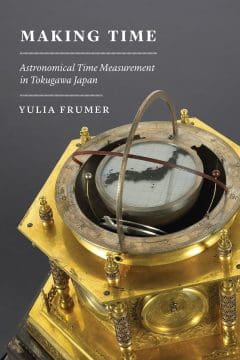
Yulia Frumer
Bo Jung and Soon Young Kim Professorship of East Asian Science, Associate Professor
Contact Information
- [email protected]
- On Leave: Academic Year Fall 2025 - Spring 2026
- Curriculum Vitae
- Gilman 380
- 410-516-7507
Research Interests: Science and technology in East Asia, especially Japan; science and technology transfer; scientific translation; measurement instruments; humanoid robotics; science fiction.
Education: PhD, Princeton University
I research the role of cognition and emotions in technological decision-making, explore material and metaphorical bases for abstract thought, and analyze design bias.
Specializing in East Asian, and specifically Japanese, science and technology, I trace technological and scientific developments from the Tokugawa period to the 21st century. My research covers various scientific disciplines such as astronomy, navigation, and engineering, and focuses on an array of objects: clocks that measure time in units of variable length, thermometers, compasses, industrial robotic arms, prosthetics, robotic pets, and androids. A staunch advocate for engaged scholarship, I maintain that diachronic analysis of scientific and technological developments illuminates the processes by which biases become embedded in objects. For me, researching the development of technologies is a step towards just and unbiased future design.
My current research, funded by the National Science Foundation, examines how emotions shaped the decisions of roboticists, policymakers, and consumers, and influenced the development of present-day robots in Japan. I show that fears of labor shortages made industry leaders take risks with experimental technologies; that masculine and national identities motivated decision-makers to chase technological pipe dreams; that class and gender biases affected engineers’ design choices and became embedded in robotic structure, function, and appearance; and that robotics engineers consciously manipulated design to elicit affection and to induce attachment in potential consumers. Present-day designs of Japanese robots, I argue, are akin to earthenware that show imprints made by these decades-old, emotionally-laden, and often biased decisions. We may no longer consciously subscribe to the values that shaped those decisions but we remain affected by their material traces still present in the design. Based on these findings I am currently finishing a book monograph, a coauthored book, and a series of articles, each illuminating a different angle of robot-making processes.
My first book, Making Time: Astronomical Time in Tokugawa Japan (Chicago, 2018), was a methodological prelude to my current work. While my current research examines the relationship between the materiality of robots and emotions, in Making Time I examined the relationship between the materiality of time-measuring devices and concepts of time. I looked at astronomers’ conceptualization of time in the context of their evolving material, visual, and practical environments. This allowed me to see that seemingly abstract notions of time were, in fact, rooted in an array of associations with visual, auditory, tactile, and calculatory aspects of astronomers’ work. In my articles from that time, I pursued similar arguments. In “Before Words,” I showed that a Japanese astronomer who did not know Dutch was able to understand some contents of a book in Dutch by utilizing his understanding of math and textual infrastructure of the book. In “Japanese Reverse Compasses,” I explained how Japanese mariners altered their perceptions of space with compasses in which East was placed on the left side of the dial and West on the right. In “Translating Words, Building Worlds” I reconstructed the process by which Japanese translators conceptualized thermometers based on their previous experience with vertical timekeepers.
My interest in hidden, taken-for granted, and subjective factors that shape scientific and technological practices stems from my personal background. I was born in Tallinn, Estonia, and have lived in Israel, Japan, Germany, and the US. Fluent in English, Hebrew, Russian, and Japanese, and conversant in several other languages, I am fascinated by the subtle differences in the meanings attached to terms that at first glance appear to be directly translatable. I have become aware of the fact that those varying meanings are not restricted to words alone but are reliant on a larger set of social practices, material environments, and linguistic metaphors. This awareness has had a profound effect on my research interests in cross-cultural knowledge and technology transfer, scientific translation, and comparative technologies. My personal experiences moving between languages, cultural norms, and built environments has provided a fertile ground for my approach to knowledge as embodied, embedded, enacted, and extended.
For more information on my book, Making Time: Astronomical Time Measurement in Tokugawa Japan, go to: http://press.uchicago.edu/ucp/books/book/chicago/M/bo27442023.html
Op-Ed: “What Tesla’s Robot Tells Us about Bias in Design,” published in Slate/Future Tense, October 24, 2022,
https://slate.com/technology/2022/10/tesla-optimus-robot-design-labor-elon-musk.html
“Manufacturing Hands: Robot Fingers and Human Labour in Post-War Japan.” History & Technology, no. Special Issue: Making History (2022): 239–256. DOI: 10.1080/07341512.2022.2129279
“The Short, Strange Life of the First Friendly Robot,” IEEE Spectrum. Vol. 57. Issue 6 (June 2020): 42-48. https://spectrum.ieee.org/robotics/humanoids/the-short-strange-life-of-the-first-friendly-robot
“The 4th IR, Humanoid Robots, and the Politics of Labor Concealment in Japan” in Medium, “What’s at Stake in a 4th Industrial Revolution?,” March 25, 2019. https://medium.com/whats-at-stake-in-a-fourth-industrial-revolution/the-4th-ir-humanoid-robots-and-the-politics-of-labor-concealment-in-japan-325ca04923af
“Cognition and Emotions in Japanese Humanoid Robotics,” History and Technology, Volume 34, issue 3 (2018): 1-27. https://www.tandfonline.com/doi/full/10.1080/07341512.2018.1544344
“Translating Words, Building Worlds: Meteorology in Japanese, Chinese, and Dutch.” Isis, Volume 109, Number 2. (June 2018): 1-7. https://www.journals.uchicago.edu/doi/abs/10.1086/697993
“Japanese Reverse Compasses: Grounding Cognition in History and Society.” Science in Context, Volume 31, Number 2. (June 2018): 155-187. https://doi.org/10.1017/S0269889718000157
“Translating Time: Habits of Western Style Timekeeping in Late Tokugawa Japan” in Technology and Culture, Volume 55, Number 4, October 2014, pp. 785-820.
“Before Words: Reading Western Astronomical Texts in Early 19th Century Japan” in Annals of Science, July 2016. Available online

Making Time: Astronomical Time Measurement in Tokugawa Japan
- author
- University of Chicago Press , 2018